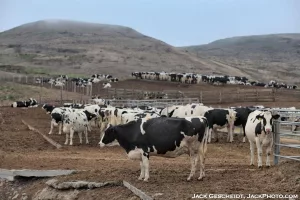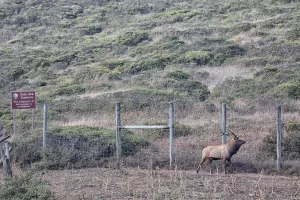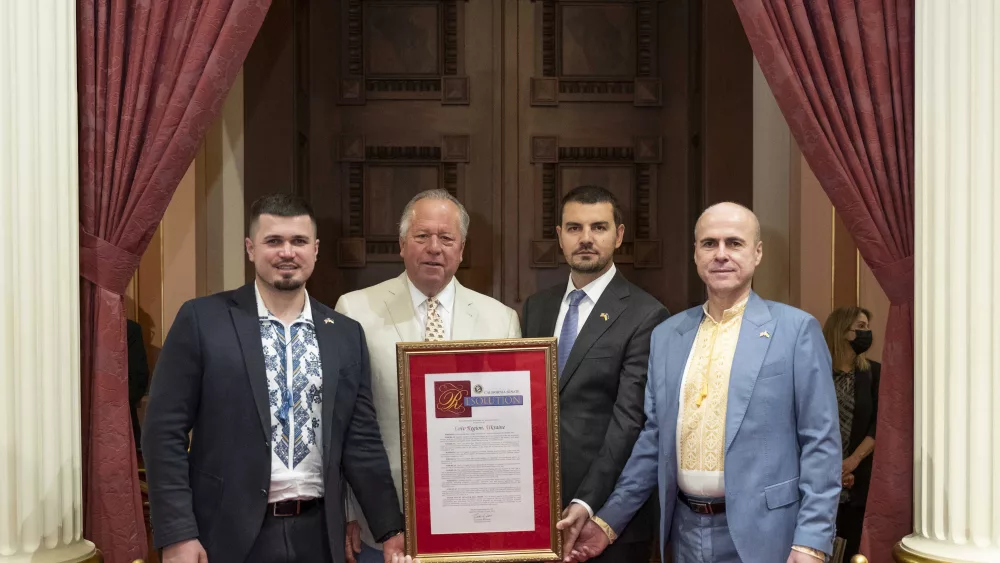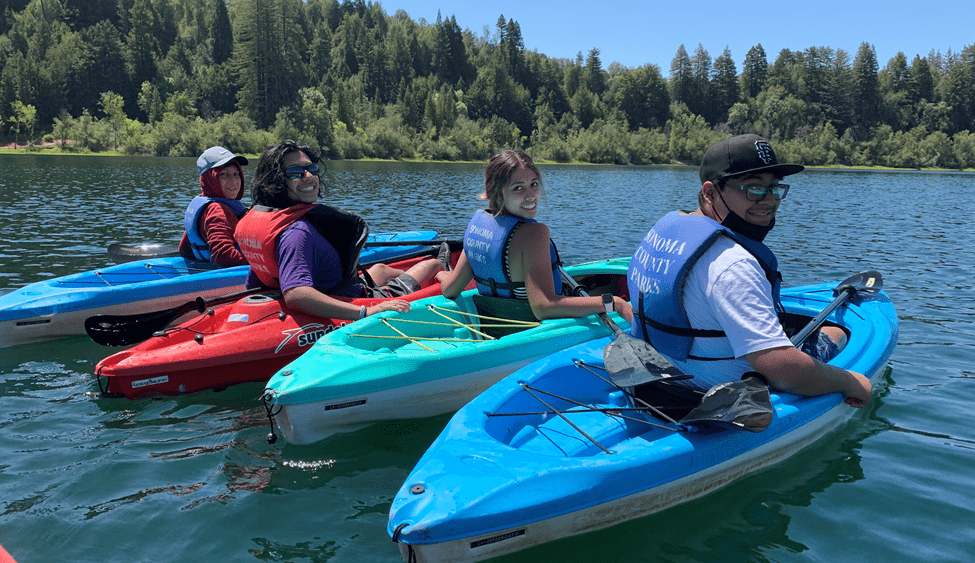![Tule elk at Point Reyes. [Photo by Jack Gescheidt, TreeSpiritProject.com]](https://dehayf5mhw1h7.cloudfront.net/wp-content/uploads/sites/1436/2023/08/07120141/double-truck-elk-horizontal1.webp)
Tule elk at Point Reyes. [Photo by Jack Gescheidt]
For centuries, tule elk roamed freely on the lands of the Point Reyes peninsula, and the Coast Miwok lived alongside them in harmony with nature. As many as half a million tule elk once lived in California, but after European settlers arrived, and ranching and farming became predominant activities, they gradually disappeared due to habitat loss and excessive hunting.
By 1870, no tule elk remained in Point Reyes.
They were locally extinct for more than a century—until 1978, when the National Park Service acquired 10 from a historic herd in Tulare County and moved them to Tomales Point, the northern tip of the Point Reyes peninsula. Today, three herds inhabit parts of Point Reyes National Seashore: one at Drake’s Beach, another at Limantour Beach and the third at Tomales Point Tule Elk Preserve, where they live in a 2,600-acre enclosure bounded by a barbed-wire fence that separates the herd from grazing cattle. During California’s most recent drought, the ponds that the Tomales Point herd depends upon for drinking water went dry, and the lack of rain diminished the nutritional quality of the grasses they eat. As a result, the elk became malnourished and dehydrated—and more than 150 died in 2021, sparking an outcry that resulted in lawsuits, finger-pointing and differing points of view on how to manage the herds.

The plight of today’s elk began with cattle ranching and the creation of a national seashore. Ranching got its start in the area during the era of Mexican land grants between 1769 and 1846, and large-scale operations began in 1869 and 1870, after San Francisco law firm Shafter, Shafter, Park and Heydenfeldt acquired more than 50,000 acres of the coastal property following a legal dispute over who had title to the land, which missionaries and settlers had taken from the Coast Miwok. They sold the northernmost part, now Tomales Point, to Solomon Pierce, who built Pierce Point Ranch, which is no longer operating but remains as a historic site. Oscar Shafter and his son-in-law Charles Howard Webb created a dairy district on the rest of the land, dividing it into 32 tenant parcels known as the Alphabet Ranches, because most of them were named for letters of the alphabet.
By the 1960s, agriculture was well established, but Marin County’s population was growing, and developers proposed extensive development for West Marin, with subdivisions and a major highway leading to Point Reyes Station. To stop development, opponents suggested creating a national seashore, and Congress passed legislation in 1962 to establish the Point Reyes National Seashore. President John F. Kennedy made it official when he signed the bill that September, but it took 10 more years to make it a reality, because the National Park Service had to buy the land. The initial allocation to purchase the land was $14 million, but Congress was slow in appropriating the funds, and land values were increasing rapidly, so the money ran out before the park service could acquire the 53,000 designated acres. “It looked like the national seashore was going to go down the tubes. … It was shaky for about 10 years,” recalls Dr. Martin Griffin, an environmentalist who tells the story in his 1998 memoir Saving the Marin-Sonoma Coast. However, a group of individuals—including Peter Behr, a Marin County supervisor from 1961 to 1970 and a California state senator from 1971 to 1978—formed an initiative called Save Our Seashore and put pressure on Congress to provide the additional federal funding. In 1970, Congress appropriated an additional $43.5 million, which allowed the NPS to buy the land from local farmers and ranchers.
The strategy was unusual, because it required the park service to buy private land but allow the owners to stay, and between 1963 and 1975, the ranchers sold their land in exchange for leases and special permits for grazing cattle. Kevin Lunny, a third-generation rancher, who grew up in the area, describes it as a big experiment and says, “The ranchers went along with it, because development would have destroyed our way of life.” The leases were for 20, 30 or up to 50 years, and the ranchers paid for them in advance with money from the sales. “A lot of people chose 20 years and thought that was a long time,” Lunny says, and they were under the impression that lease renewals would continue in perpetuity. They discovered otherwise in 2014, when Lunny had to vacate the property where he operated Drake’s Bay Oyster Company, after then-Interior Secretary Ken Salazar used his discretionary power to decide against renewing the lease in the first instance of a denial.
Environmentalists understood that ranching would be retained temporarily, but were under the impression that when the leases expired, agricultural lands would become wilderness. “Peter Behr didn’t expect it to be farmland for so long,” says Griffin, who adds that not all the ranchers were happy about having to sell their land. In 1969, the Pacific Sun weekly produced a special section called Save our Seashore, and Griffin recalls that most copies were destroyed, with ranchers the main suspects. “They didn’t want to save the coast for visitors and enjoyment of wildlife. They wanted it for ranching,” he says, lamenting the loss of coastal prairie that was once habitat for elk, as well as the flora that used to cover much of the land.
Although further legislation in 1976 created the Point Reyes Wilderness, dedicating a portion of the seashore to nature, turning ranchland into wilderness was not the NPS’s intent. While national parks make preserving landscapes a priority, national seashores allow a variety of uses, including some development, and the legislation that established the PRNS created a pastoral zone that intentionally allowed ranching to continue. Thus, creating a seashore rather than a park was a way for the NPS to protect agricultural operations and the livelihoods of people who depend on them, such as feed suppliers and veterinarians. In addition, it preserved an income base for Marin County. Elk no longer lived in the area, so they weren’t a consideration at the time.

When the elk returned to Tomales Point in 1978, they were isolated behind a fence to prevent the potential spread of communicable diseases that infect both cattle and elk. The fence was also to keep the elk off the rangelands where leaseholders raised cattle so the two species wouldn’t compete for food. The arrival of the elk didn’t change much for most ranchers. (The McDonald family, tenants of the Pierce Point Ranch property at the time the park service obtained ownership, lost their lease on the ranch; a subsequent lawsuit against the NPS failed and they were eventually evicted.)
Grizzly bears are the tule elks’ apex predator, but they no longer inhabit the Point Reyes area, and while mountain lions also prey on elk, they number too few to make a difference. Thus, the herds need population control, or they’ll grow unchecked and outgrow their habitat, putting them at risk for starvation and disease. By 1998, the elk’s numbers had grown significantly, and the acres they inhabited weren’t sufficient to sustain a larger herd. The park service considered removing the fence but decided against it and moved some of the animals to Drake’s Beach instead. Some of the elk later appeared at Limantour Beach—some people believe they swam across Drake’s Estero—and became a free-ranging herd in the wilderness zone. Staff at PRNS do an annual census, usually in the fall, after spring calving, and in 2022, they counted 262 elk at Tomales Point, an increase of 41 from the previous year, and 170 at Drake’s Beach, up 19. They were unable to do a count in the Limantour wilderness due to inclement weather, but the tally the previous year was 169.
State of the elk
Jack Gescheidt, founder of the conservation nonprofit Tree Spirit Project and a tule elk consultant for In Defense of Animals, an animal protection organization in San Rafael, learned about the elk’s condition when he viewed Skylar Thomas’ documentary The Shame of Point Reyes, which takes a highly critical look at the land management practices of the ranchers and the park service. “I was aghast. I was shocked,” he says. “If you drive into the park, everything looks fine,” he says, but away from the roads, the reality can be different. Northern California entered a prolonged period of drought early in 2020, and the elk struggled to find water and suitable grasses for forage. Unable to bear the sight of the emaciated creatures, animal lovers started carrying water into Tomales Point to replenish the ponds after they dried up. The first water drop was in July 2020, shortly before the Woodward Fire burned 5,000 acres of the seashore’s wilderness. The largest bucket brigade took place on Aug. 28, 2022, when a caravan of 100 people, some carrying jugs and others with non-motorized wheeled vehicles, ferried water 3 miles to the elk preserve on a hot summer day. “Park rangers were there. They knew me at the point,” says Gescheidt, who had previously been cited, and although two rangers on horseback filmed the activity, they didn’t try to stop it or issue further citations. “We took in over a ton of water by hand,” he says, and he considers it a successful day.
A Point Reyes National Seashore spokesperson, who asked not to be named because of pending litigation, reports that seashore staff also provided supplemental water—something they’d never done before—because of the severity of the drought. In addition, the Federated Indians of Graton Rancheria donated $20,000 for mineral blocks and water troughs for the enclosed elk in 2021, in accordance with an agreement with the NPS that gives them a say in wildlife management at the seashore, as well as the preservation of Miwok archaeological sites.
In addition to hands-on action, Gescheidt also became a plaintiff in a legal suit that the Animal Legal Defense Fund, a national nonprofit based in Cotati, filed in June 2021, with representation pro bono by Harvard Law School’s Animal Law & Policy Clinic. Gescheidt explains that Harvard was seeking plaintiffs and approached him because he’s a photographer who visits the seashore, and has witnessed the situation first hand.
Animal Legal Defense Fund managing attorney Christopher Berry explains that several individuals who visit the national seashore and appreciate seeing the elk were horrified by their condition and became plaintiffs, as did the ALDF itself. “Many people are aggrieved by the management of the tule elk, and several came together to challenge the national government’s failure to update its mandate for managing the elk,” he says, adding that the NPS appears to favor the interests of for-profit ranching over native elk, which he says they regard as a nuisance. The intent of the lawsuit was to compel the NPS to update its management plan and take action to protect the elk. However, Judge Haywood S. Gilliam, Jr., of the Oakland Division of United States District Court, Northern District of California, ruled against the plaintiffs earlier this year, explaining that when the NPS updates its management plan is at its own discretion. “All we’re asking for is for the government to follow the plain text of the statute. Asking the NPS to update the plan in a timely manner is a reasonable request,” says Berry, who has filed an appeal. “At the end of the day, this is the federal government letting animals die on national park land to favor commercial enterprise. Every taxpayer should be offended by that.”
Making a plan
The Point Reyes National Seashore spokesperson explains that the seashore follows the mission and policy of the National Park Service, operating the same way as every national park, and its specific enabling legislation allows dairy farming. To create a plan, different entities engage in planning at the national and regional level, while PRNS considers natural and cultural resources as well as wilderness, solicits feedback from the public and works with cooperating agencies to understand the issues. “Ranches as leaseholders weigh in at every step of the way,” says the spokesperson, and the Federal Indians of the Graton Rancheria in Sonoma County are involved, giving the PRNS a relationship with a federally recognized tribe that represents the Coast Miwok and southern Pomo. “We find that there is really an in-depth public engagement,” she says, observing that including a variety of perspectives results in a better plan.
Although PRNS is on land that the Miwok inhabited for thousands of years, the Coast Miwok Tribal Council of Marin doesn’t have federal recognition and therefore doesn’t have input into the management plan. Nonetheless, today’s Miwok care deeply about their ancestral lands and the wildlife that sustained their people. “If we had enough land to help the tule elk, we’d do that,” says Preservation Officer and Cultural Advisor Jason Deschler, who grew up in Marshall. He observes that the elk would graze if they had enough space, but instead they’re starving on land that doesn’t provide enough resources. He adds that his ancestors lived on salmon and tule elk, but they respected the animals and managed the land. Among their practices were controlled burns, because fire is important for maintaining a habitat where animals can graze. “There’s a certain way you do it. You don’t just thin out the land and leave it alone,” he said, pointing out that after a fire, the grass grows back lush and healthy, providing good, nutritious forage for elk. He observes that land for grazing cattle surrounds the elk, who can’t get out, as if they were trapped on an island. “Why aren’t we protecting them?” he asks. He adds that his people have tribal knowledge and should be involved. “Our families built that park. The tables have turned on us, and we have really been left out.”
Lunny believes the seashore needs both resource and population management. “Tule elk are lowland grazers. They eat grass,” he says, explaining that Tomales Point was once a beautiful, open rangeland with a lot of grass. However, it’s become choked with brush that elk don’t eat. “The way to manage isn’t to be hands-off preservation with no burning or grazing. If we don’t do anything, the habitat will be lost, and the elk will suffer,” he says. He describes them as beautiful native animals and adds that the NPS needs to manage the numbers as well resources, perhaps by contraception, capture-and-move or lethal measures—and if they did, tule elk and cattle would be able to coexist and thrive. He believes the current management plan provides the guidance and tools, but the NPS hasn’t adhered to it.
Will PRNS bring down the fence?
Many critics believe that PRNS needs a new management plan that will be more effective and address their issues. It has made a start with the Tomales Point Management Plan, a specific plan for one area of the seashore that is based on the severity of recent droughts and its impact on elk and other resources. Others believe it falls short, however, because it doesn’t consider the effect decisions relating exclusively to Tomales Point could have on other parts of the seashore. Lunny points out that removing the fence would allow elk to enter rangeland and damage ranch property, but, conversely, “Cattle would move into the elk range at Tomales Point, thereby reducing the quality of range for the elk and exposing cattle and elk to each other’s diseases.”
A 30-day public comment period opened in March 2023, and PRNS received more than 4,000 pieces of correspondence. Based on the comments, the NPS announced in June that it had identified an action that includes “removal of the tule elk fence and temporary water systems installed during the most recent drought, evaluation of opportunities to improve recreational uses and visitor experience at the historic Pierce Point Ranch and within the Congressionally designated wilderness and approaches to best protect natural and cultural resources.” The NPS will present the proposed plan for public review later this summer.

More than 2 million people visit Point Reyes National Seashore each year, and the draw for most of them is nature, so they’re counting on the NPS to preserve it. And while a solution might be elusive, with open minds and cooperation, it just might be possible.





4 thoughts on “Beasts of No Nation: Marin Grapples With Fate of the Point Reyes Tule Elk”
The Elk should not be confined. The farmers and their cows should appreciate the wild animals.
If you want to learn more about this subject, do yourself a favor and visit MissionRewild.org – there you can learn firsthand about the tule elk discussed here and the die-off uncovered by wildlife photographer Matthew Polvorosa Kline back in 2020. He has been documenting these elk for many years and has spent thousands of hours in the Tomales Point Tule Elk Reserve. Thank you NorthBayBiz for covering this topic.
Point Reyes is very complex and not easy to cover. Unfortunately there are several problems with this story. I am in touch with the author, but still waiting for the editor contact me about corrections. First problem:
“…the ranchers sold their land in exchange for leases and special permits for grazing cattle.” You’d think it would be obvious that they also received fair market value payments for their land (this is a matter of record), but there are some pro-ranching factions here and there who will falsely claim the ranchers either donated their land, or that it was taken from them via eminent domain. Also, initially, they did not receive leases or permits at all, but rather Reservations of Use and Occupancy (ROUs) with finite terms.
The omitted distinction allows the ranchers to claim they expected to be there forever, that this was known (“the deal”), and in fact Mr. Lunny claims exactly that. Next point:
“Lunny says, and they were under the impression that lease renewals would continue in perpetuity. They discovered otherwise in 2014…” This is completely misleading. Secretary Salazar’s decision to close the oyster company was not “discretionary,” except in the mundane sense that he had to decide what to do. The opening paragraph of his decision statement (attached) says “This decision is based on matters of law and policy…” The oyster company was in designated potential wilderness. Secretary Salazar followed the law, nothing more. To omit this plain fact serves a false narrative portraying Mr. Lunny and his cohorts as victims of big government caprice, a notion that they actively support.
Move the fence outward, expanding the elk’s range, and decreasing the cow’s . I doubt those cows are happy anyway, especially when they’re hooked up to milking machines. They will still be “free range” and organic, and the people who pay extra for those labels won’t know the difference.